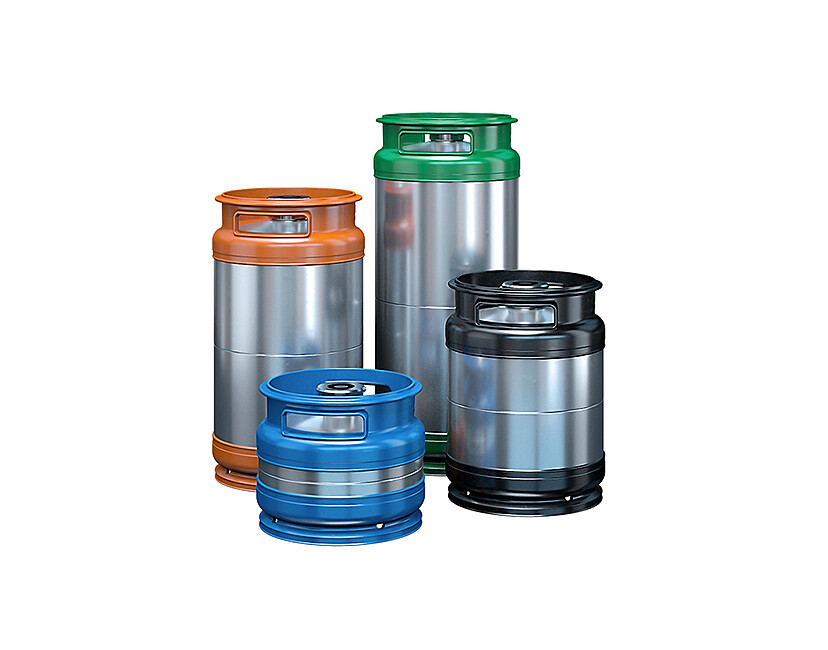Topics
Packaging can’t escape digitalisation either, of course. But for KEGS, that doesn’t just mean the barrels will become more intelligent and be able to communicate specific data, such as filling amount or temperature. It also includes new KEG Apps that make the product more accessible for customers, make enquiries easier and consequently speed up the decision to buy. Combined with current trends, lighter containers, for instance, this opens up new possibilities for transport and logistics.
In over 50 years, the KEG developed from initially being no more than an alternative to wooden barrels to becoming an indispensable packaging form for the beverage industry. Constant development and improvement has led to KEGs today being used for all beverage types: typically for beer, of course, but also for non-carbonated alcoholic and non-alcoholic beverages, for soft drinks and even for spirits and coffee. It’s only logical, therefore, to continue optimizing KEGs above and beyond their components, size and materials.
KEG development is now being significantly influenced by two current trends: sustainability and lightweight construction. The former is proving a general boost to the popularity of stainless steel reusable KEGs, as they are far more ecological. With an average of four cycles per year, these KEGs can be used for up to 30 years when used appropriately, which leads to much lower CO2 emissions being generated than in the production of new disposable containers. At the same time, they are 100% recyclable. This also brings in economic aspects: for 30-litre KEGs for example, the cost per beer dispensed is only one twentieth of that dispensed from a plastic KEG, when scrap value and multiple use are also factored in – despite the higher one-off acquisition costs.
Fortunately, sustainability is a trend that is generally becoming increasingly prevalent in the beverage industry, too, in the form of re-usable packaging. This is a very sensible and ethically desirable change in attitude to the entire issue, as the emphasis is very much on responsible use of resources. In addition, stainless steel KEGs in no way impair the flavour or quality of the beverages they contain This is a complete contrast to plastic, from which substances can generally leach into the environment and have quite harmful effects. Lighter reusable packaging forms, on the other hand, offer beverage producers different benefits. They were developed with the idea of saving resources and it’s the reduction in material input that is decisive for bringing down KEG weight by up to 36%.
At the same time, there are two further trends which can currently be observed. One is the move towards slimmer KEGs. Combined with the stackability most KEGs now have, the weight reduction and better space utilization create a logistics benefit: a standard 40-foot container can now take up to 6 % more full KEGs on board.
The second trend shows the growing popularity of self-sufficient dispensing systems, driven by the fun people have in tapping their own beer wherever they want to.

Finally, the same thing that applies to coffee machines and fridges also applies to KEGs: the trend towards intelligent solutions. In future, packaging will also make use of digitalisation and, for instance, move towards IoT. This means it would be able to provide information on type of beverage or brand, but also on the KEG’s filling amount, the temperature and the pressure inside. At the same time, these KEGs of the future will be able to transmit their location even more exactly, making more precise planning possible and consequently improved logistics. This transmission of specific data will also have a positive influence on traceability, making it much easier to deal with the disappearance of KEG stocks.
Intelligence appears in other aspects surrounding KEGs; in Apps for instance. Here, digitalisation makes KEGs more accessible for buyers, makes enquiries easier and consequently speeds up or even automates the decision to buy. Users can gain an initial insight into the variety of available KEGs and the potential for individual brand presentation. They can send their personally configured KEG as an inquiry directly to sales, save it on their phones or share it with friends. This way, apps can streamline the entire purchasing process, from decision-making support to reducing bad buys by depicting the product precisely before purchase.
An example: after selecting a volume and type of diameter, users are shown the available types for this combination in the next step. They can choose from volumes of 5 to 50 litres, or 1/6 to 1/2 barrels for the American market. These can then be optically and technically adapted to their personal needs: for example by colouring the stripes, the polyurethane (PU) coating or top and bottom rings, as well as applying logos to the KEG using a range of different techniques. Different fitting types and other technical accessories can also be selected.
Packaging is not only how your brand makes its first impression. Packaging is much more. In the beverage sector especially, it serves to protect products of all kinds. Driven by the need for process optimisation, by digital impulses and general trends, it is also constantly developing in an increasingly complex structure of requirements and demands. As a result, new potential is constantly being discovered, niches used intelligently and, above all, issues like the sustainable use of resources are being taken into account. Anyone purchasing packaging for their products either today or in future is increasingly being asked to make ecologically based decisions on the one hand, while being able to justify consciously taking decisions in favour of their customers on the other. Those who back sustainability here and consciously challenge the packaging manufacturers by confronting them with new requirements will play their own part in contributing to new exciting trends that could well generate significant change for the market and for the future.